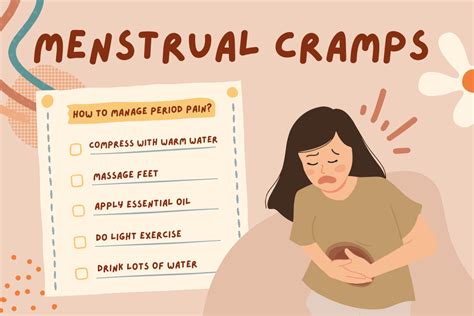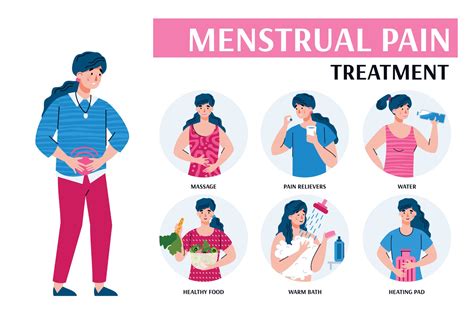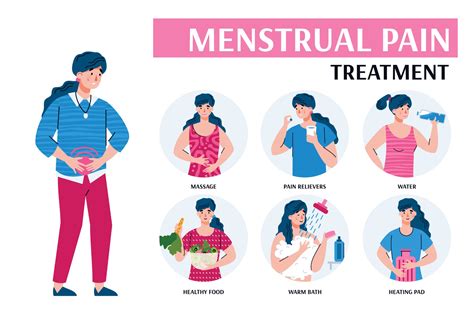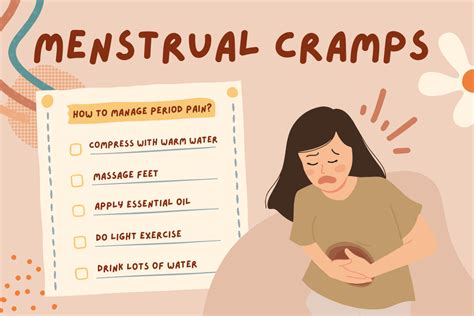Intro
Find relief for cramps with natural remedies and pain management techniques, alleviating menstrual cramp symptoms, muscle spasms, and cramping pain through relaxation methods and dietary changes.
Menstrual cramps, also known as dysmenorrhea, are a common issue affecting millions of women worldwide. The discomfort and pain associated with menstrual cramps can range from mild to severe and may interfere with daily activities. Understanding the causes, symptoms, and available relief methods is essential for managing menstrual cramps effectively. Menstrual cramps are a natural part of the menstrual cycle, but that doesn't mean women have to suffer in silence. With the right approach, it's possible to find relief and take control of menstrual health.
The experience of menstrual cramps varies from woman to woman. Some may feel a dull ache in the lower abdomen, while others may experience sharp pains that radiate to the back and thighs. The severity of the pain can be influenced by various factors, including hormonal changes, uterine contractions, and individual tolerance to pain. Despite the varying degrees of discomfort, there are several strategies that can help alleviate menstrual cramps. From lifestyle changes and home remedies to medical treatments and alternative therapies, the options for relief are diverse and can be tailored to suit individual needs.
Finding effective relief from menstrual cramps is crucial for maintaining quality of life. When left unmanaged, menstrual cramps can lead to missed workdays, strained relationships, and a general feeling of being unwell. By exploring the different relief methods and finding what works best, women can regain control over their menstrual health and live life to the fullest. Whether it's through dietary changes, exercise, heat therapy, or medication, there are numerous ways to combat menstrual cramps. Understanding these options and how they can be integrated into daily life is the first step towards a cramp-free menstrual cycle.
Understanding Menstrual Cramps

Causes of Menstrual Cramps
The causes of menstrual cramps can be broadly categorized into primary and secondary dysmenorrhea. Primary dysmenorrhea refers to menstrual cramps that are not caused by any underlying medical condition, while secondary dysmenorrhea is associated with conditions such as endometriosis, uterine fibroids, or pelvic inflammatory disease. Understanding the underlying cause of menstrual cramps is essential for developing an effective treatment plan.Relief Methods for Menstrual Cramps

Lifestyle Changes for Relief
Making lifestyle changes can play a significant role in managing menstrual cramps. Some of the lifestyle changes that can help alleviate menstrual cramps include: - Stress management: Engaging in stress-reducing activities such as meditation, yoga, or deep breathing exercises can help reduce the severity of menstrual cramps. - Getting enough sleep: Aim for 7-8 hours of sleep per night to help regulate hormones and reduce pain. - Staying hydrated: Drinking plenty of water can help reduce bloating and promote overall health.Medical Treatments for Menstrual Cramps

Alternative Therapies for Relief
Alternative therapies such as acupuncture, massage, and herbal supplements can also provide relief from menstrual cramps. Some of the most effective alternative therapies include: - Acupuncture: This traditional Chinese medicine technique involves inserting thin needles into specific points on the body to stimulate healing and reduce pain. - Massage: Massaging the lower abdomen and back can help relax the uterine muscles and reduce pain. - Herbal supplements: Certain herbal supplements such as ginger, turmeric, and omega-3 fatty acids have anti-inflammatory properties that can help reduce pain and inflammation.Managing Menstrual Cramps

Preventing Menstrual Cramps
While it may not be possible to completely prevent menstrual cramps, there are several strategies that can help reduce their severity. Some of the most effective ways to prevent menstrual cramps include: - Maintaining a healthy weight: Excess weight can put additional pressure on the uterus and worsen menstrual cramps. - Avoiding triggers: Identifying and avoiding triggers such as stress, certain foods, or activities can help reduce the severity of menstrual cramps. - Staying active: Regular physical activity can help reduce inflammation and promote overall health.Conclusion and Next Steps

What are the most common symptoms of menstrual cramps?
+The most common symptoms of menstrual cramps include lower abdominal pain, back pain, thigh pain, nausea, vomiting, and headaches.
How can I relieve menstrual cramps at home?
+Some effective ways to relieve menstrual cramps at home include applying heat to the lower abdomen, taking over-the-counter pain relievers, practicing relaxation techniques such as meditation or deep breathing, and engaging in regular physical activity.
When should I seek medical attention for menstrual cramps?
+You should seek medical attention for menstrual cramps if you experience severe pain that interferes with daily activities, heavy bleeding, fever, or vomiting. Additionally, if you suspect that your menstrual cramps are caused by an underlying medical condition, you should consult with a healthcare provider for proper diagnosis and treatment.
We hope this article has provided you with valuable insights and practical tips for managing menstrual cramps. If you have any further questions or would like to share your experiences with menstrual cramps, please don't hesitate to comment below. Additionally, if you found this article helpful, please consider sharing it with friends and family who may be struggling with menstrual cramps. Together, we can work towards creating a community that supports and empowers women to take control of their menstrual health.
